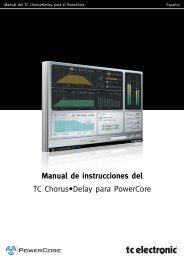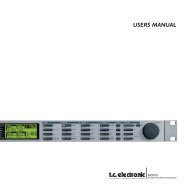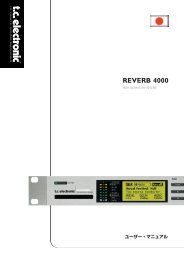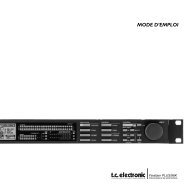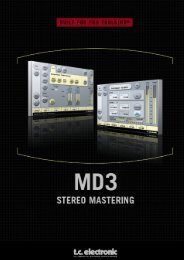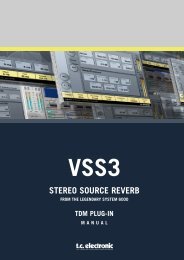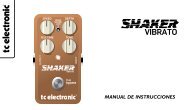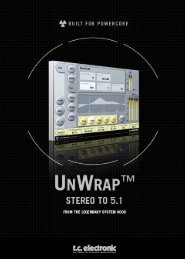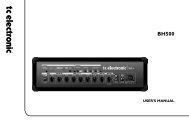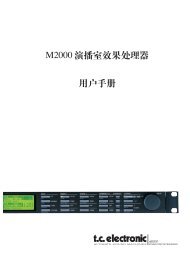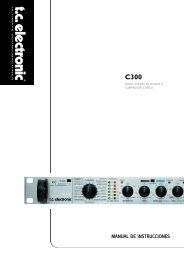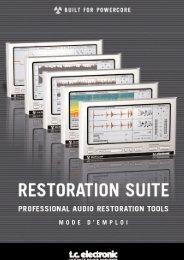CLASSIC VERB - TC Electronic
CLASSIC VERB - TC Electronic
CLASSIC VERB - TC Electronic
Create successful ePaper yourself
Turn your PDF publications into a flip-book with our unique Google optimized e-Paper software.
BUILT FOR POWERCORE<br />
<strong>CLASSIC</strong> <strong>VERB</strong><br />
USER MANUAL<br />
ENGLISH<br />
<strong>CLASSIC</strong> <strong>VERB</strong> / 99
INTRODUCTION<br />
<strong>CLASSIC</strong> <strong>VERB</strong> has been modelled after a world renowned studio reverb to achieve<br />
its distinctive rich and textured classic reverb sound. <strong>CLASSIC</strong> <strong>VERB</strong>’s algorithm<br />
follows a completely different design philosophy and is unlike any reverb <strong>TC</strong> Works has<br />
done in the past, offering a completely different sound from MegaReverb. Apart from<br />
the elegant user interface, <strong>CLASSIC</strong> <strong>VERB</strong> features a choice of modulation types for<br />
sonically rich timbres. Fifteen room types provide a wealth of different unique spaces,<br />
featuring Halls, Plates, Cathedral, Spring as well as three rooms tuned especially for<br />
vocal processing.<br />
2 instances of the Plug-In require only one single DSP to run, allowing a total of up to<br />
8 <strong>CLASSIC</strong> <strong>VERB</strong>s on a single POWERCORE – still leaving room for some other<br />
Plug-Ins like EQs and Compressor Limiters. And of course, 24/96 is supported.<br />
Enjoy!<br />
The <strong>TC</strong> WORKS Team<br />
ATTENTION!<br />
THIS IS A POWERCORE PLUG-IN AND REQUIRES POWERCORE TO BE INSTALLED<br />
IN THE COMPUTER! THIS PLUG-IN WILL NOT RUN WITHOUT POWERCORE.<br />
ENGLISH<br />
is a <strong>TC</strong> Group company.<br />
© BY <strong>TC</strong> WORKS SOFT & HARDWARE GMBH 2002. ALL PRODUCT AND COMPANY NAMES ARE TRADEMARKS OF THEIR RESPECTIVE OWNERS.<br />
ALL SPECIFICATIONS SUBJECT TO CHANGE WITHOUT NOTICE. ALL RIGHTS RESERVED.
GETTING STARTED<br />
SYSTEM REQUIREMENTS<br />
Windows<br />
• POWERCORE running system 1.6 or later<br />
• Windows 98SE, ME, 2000 or XP<br />
• PIII 500 or faster<br />
• 128 MB RAM<br />
• VST compatible Host Application<br />
• System must meet requirements of the Host Application<br />
Mac OS<br />
• POWERCORE running system 1.6 or later<br />
• MacOS 9.04 or higher (Mac OS X when available)<br />
• G3/300 or faster<br />
• 128 MB RAM<br />
• VST or MAS compatible Host Application<br />
• System must meet requirements of the Host Application<br />
GENERAL<br />
GLOBAL CONTROLS<br />
• To enter a numeric value in any <strong>CLASSIC</strong> <strong>VERB</strong> control, double-click on a<br />
parameter’s value field and a pop-up field for numeric entry will appear. Confirm the<br />
edited value by pressing or cancel the input by pressing .<br />
• To reset a control to its default value, press and click on the desired control.<br />
• + clicking a control will behave as a fine tune adjustment.<br />
A / B<br />
The ”A / B” function of <strong>CLASSIC</strong> <strong>VERB</strong> allow for a quick comparison of two different<br />
settings. Select ”Store” and then ”A” or ”B” to save a setting into either the ”A” or<br />
”B” memory. After setting up both an ”A” and a ”B” setting, you can simply select<br />
either ”A” or ”B” to immediately compare the two settings.<br />
As these are meant for a quick comparison, these settings are LOST when closing the<br />
Plug-In! If you love your preset, we advise you to save it!<br />
ENGLISH<br />
<strong>CLASSIC</strong> <strong>VERB</strong> /<br />
1
OVERVIEW<br />
1 2 4<br />
3<br />
8<br />
7 6 5<br />
ENGLISH<br />
1. Reverb Controls<br />
2. Modulation Controls<br />
3. Active Modulation Display<br />
4. Input / Output Gain and Meter<br />
5. Wet (effected) / Dry (source) Mix<br />
6. Highcut Filter<br />
7. Color<br />
8. Preset Manager<br />
2 / <strong>CLASSIC</strong> <strong>VERB</strong>
<strong>CLASSIC</strong> <strong>VERB</strong><br />
RE<strong>VERB</strong> CONTROLS<br />
The Reverb Designer is an interactive control for your Initial Reflections and Reverb<br />
Decay. You can click on the arrows to freely adjust the gain of these parameters.<br />
These parameters are also available in more traditional control dialogues.<br />
1<br />
2<br />
1. Initial Reflection Pre-Gain<br />
2. Decay Gain (dB)<br />
3. Delay Time (0-200 MS)<br />
4. Reverb Decay Time<br />
3<br />
4<br />
Note: Unlike MegaReverb, there is no independent control for the delay time for the<br />
Initial Reflections and Reverb Decay.<br />
The Reverb Controls can be edited by double clicking into the field and typing the data,<br />
or you can use the arrows to scroll parameter values.<br />
ENGLISH<br />
<strong>CLASSIC</strong> <strong>VERB</strong> /<br />
3
RE<strong>VERB</strong> TYPE<br />
Reverb Type is one of the more important parameters of <strong>CLASSIC</strong> <strong>VERB</strong>. By changing<br />
the Reverb Type, you will completely change the characteristic sound of the reverb.<br />
This will effect such parameters as the Initial Reflections, the Reverb Types, and the<br />
Modulation available.<br />
01 Classic Hall 06 Drum Room 11 Plate I*<br />
02 Vocal Studio 07 Cathedral 12 Plate II<br />
03 Vocal Room 08 Ambience 13 Club<br />
04 Vocal Hall* 09 Live Reverb 14 Living Room<br />
05 Drum Box 10 Spring 15 Living Room<br />
Note: Room types marked with an asterisk (*) do not have pre-gain! When a room type<br />
without a pre-gain is selected, the pre-gain control will disappear.<br />
PRE GAIN<br />
The Pre-Gain control sets the level of the reverb’s Initial Reflections.<br />
DECAY GAIN<br />
The Decay gain control sets the level of the reverb’s decay. By minimizing the Decay<br />
Gain and increasing the Pre-Gain to maximum, you can create the room impressions<br />
without adding ”mud” to the mix.<br />
DELAY<br />
The Delay control delays the starting point of the reverb’s Initial Reflections and decay.<br />
This parameter can be used to change the sense of the size of the room, i.e. to make<br />
the room larger, increase the Delay time so that the reverb’s decay starts later. The<br />
maximum delay time allowed by the algorithm is 200 ms.<br />
DECAY TIME<br />
By grabbing the Decay Time controller, you can easily adjust the length of the reverbs<br />
decay tail. Longer decay times make the space seem larger, while smaller decay times<br />
will make a room sound smaller or boxier.<br />
ENGLISH<br />
4 / <strong>CLASSIC</strong> <strong>VERB</strong>
MODULATION CONTROLS<br />
MODULATION TYPE<br />
Modulation adds a subtle and tasteful amount of animation to the reverb decay<br />
creating very rich and sonically complex decays. In addition to being set to ”off”, there<br />
are 3 types of modulation for the decay of the reverb. The modulation types each have<br />
different characteristics, and vary by the room type that is selected.<br />
TYPE<br />
0 I II III<br />
Off Wide Rich Deep<br />
WIDTH<br />
The Width parameter, indicated by “W”, controls the width<br />
of the modulation. Double click to enter a parameter value or<br />
scroll through the width range with the arrows.<br />
DEPTH<br />
The Depth parameter, indicated by “D”, controls the depth<br />
of the modulation. Double click to enter a parameter value or<br />
scroll through the depth range with the arrows.<br />
ACTIVE MODULATION DISPLAY<br />
The modulation display will show the width and depth of the modulation on the<br />
reverbs decay. You can edit both the width and depth simultaneously in the display.<br />
IN / OUT METERS<br />
The meters monitor the Input and Output levels in dB and feature a<br />
Peak Hold option. The CLIP leds will turn red if signal ever reaches 0dB<br />
or greater.<br />
ENGLISH<br />
<strong>CLASSIC</strong> <strong>VERB</strong> /<br />
5
METERING OPTIONS<br />
Our Peak Hold metering is designed to track and hold the peak signals for about 2<br />
seconds. You can move the cursor anywhere in the meter display and click-hold the<br />
mouse button to reveal the Display options for Peak Hold.<br />
ACTIVATE PEAK HOLD<br />
Selecting this from the ”Display” options will activate the Peak Hold.<br />
DEACTIVATE PEAK HOLD<br />
Selecting this from the ”Display” options will deactivate the Peak Hold.<br />
RESET PEAK HOLD<br />
Selecting this from the ”Display” options will reset the Peak Hold.<br />
NIGHT VISION<br />
Selecting this from the ”Display” options will activate the ”Night Vision” lamp, which<br />
may be required for those late night mix sessions. ; -)<br />
WET / DRY MIX<br />
This parameter sets the balance between the source signal and the processed signal.<br />
At 0%, you will only hear the source, while at 100% you will only hear the signal<br />
processed with <strong>CLASSIC</strong> <strong>VERB</strong>. When you are using <strong>CLASSIC</strong> <strong>VERB</strong> in a send/return<br />
configuration, you should set the Mix to 100% to bypass the dry signal.<br />
ENGLISH<br />
6 / <strong>CLASSIC</strong> <strong>VERB</strong>
HIGH CUT FILTER<br />
The input to <strong>CLASSIC</strong> <strong>VERB</strong> is processed with a low pass filter which allows you to roll<br />
off the high frequencies of your reverb effect. In general, you will want to make your<br />
reverb effect a bit darker than the source signal, as it might otherwise sound unnatural<br />
or even unpleasant.<br />
FREQUENCY<br />
Sets the cut-off frequency for <strong>CLASSIC</strong> <strong>VERB</strong>’s input filters. Use this to band-limit the<br />
early reflection and decay characteristics of the effect.<br />
GAIN<br />
Defines how much the input to <strong>CLASSIC</strong> <strong>VERB</strong> is damped in the high-frequency area.<br />
The scale of the filter is 6dB / octave.<br />
COLOR<br />
These parameters change overall tonal characteristic of your reverb preset. With some<br />
simple adjustments, the ”color” of your reverb can vary from bright and shining to dark<br />
and mellow.<br />
LO<br />
The LO color controller affects the low frequency content of the processed signal.<br />
By increasing the LO color parameter, you will hear a resulting increase in the low<br />
frequency content of the reverb. By contrast, reducing the LO color parameter value<br />
will result in a decrease in the low frequency content of the reverb.<br />
HI<br />
The HI color controller affects the high frequency content of the processed signal.<br />
By increasing the HI color parameter, you will hear a resulting increase in the high<br />
frequency content of the reverb. By contrast, reducing the HI color parameter value<br />
will result in a decrease in the high frequency content of the reverb.<br />
Note: If the High Cut filter is activated, boosting the HI color parameter may not have<br />
an impact on the overall tonal characteristics of the sound.<br />
Note: Typically, reverbs that are described as ”cold” have a high frequency content that<br />
is not normally present in most naturally occurring reverbs. To get a ”warmer” or more<br />
natural reverb, increase the LO color and decrease the high color parameter values.<br />
Alternatively, you can use the Highcut filter to further reduce the high frequencies.<br />
ENGLISH<br />
<strong>CLASSIC</strong> <strong>VERB</strong> / 7
PRESET MANAGER<br />
<strong>CLASSIC</strong> <strong>VERB</strong> features a comprehensive file based preset architecture that makes<br />
archiving presets a breeze. This allows you to organize your presets in a way you find<br />
most comfortable for your workflow, and to exchange presets and curves with other<br />
users, no matter what platform or application they are using.<br />
Presets are saved as discrete files on your hard drive. Once a preset is saved into the<br />
default location, it will automatically appear in the ”File” menu every time you use the<br />
Plug-In. The files can then be arranged in sub-folders, which will also be recognized by<br />
the Plug-In.<br />
FILE<br />
Pressing the ”File” button will open up the file menu. The following options are<br />
available from the file menu.<br />
LOAD PRESET<br />
By selecting ”Load”, you can navigate to any folder on the system, including any<br />
”Shared” folder. By default, these will be loaded from the default location for<br />
<strong>CLASSIC</strong> <strong>VERB</strong> presets.<br />
Only presets located in the default file location will appear in <strong>CLASSIC</strong> <strong>VERB</strong>’s pop-up<br />
preset menu.<br />
SAVE PRESET<br />
By selecting ”Save”, you can save your preset to any folder on the system, including<br />
any shared folder. By default, these will be saved to the default location for<br />
<strong>CLASSIC</strong> <strong>VERB</strong> presets.<br />
<strong>CLASSIC</strong> <strong>VERB</strong> can arrange presets into<br />
different sub-folders. These subfolders<br />
are sorted into basic reverb types such as<br />
Rooms, Halls, etc.<br />
You can delete, re-arrange or create your<br />
own folders to accommodate your needs.<br />
You could, for example, create preset<br />
folders for projects, customers, or by genre.<br />
ENGLISH<br />
8 / <strong>CLASSIC</strong> <strong>VERB</strong>
DEFAULT PRESET LOCATIONS:<br />
The following locations will describe where you can find your <strong>CLASSIC</strong> <strong>VERB</strong> presets,<br />
which are stored in different folders.<br />
MacOS Classic: files are stored in the System folder.<br />
System Folder: Application Support : <strong>TC</strong>Works : POWERCORE: <strong>CLASSIC</strong> <strong>VERB</strong>: Presets<br />
MacOS X: files are stored in your user folder.<br />
Users: Your Name: Library: Application Support : <strong>TC</strong>Works : POWERCORE :<br />
<strong>CLASSIC</strong> <strong>VERB</strong>: Presets<br />
Windows: files are stored on the Windows OS Hard Drive.<br />
System Hard Drive:\Program Files\<strong>TC</strong>Works\System\Application Support\POWERCORE\<br />
<strong>CLASSIC</strong> <strong>VERB</strong> \ Presets<br />
• To delete a file, simply move the file to the ”Trash” or ”Recycle bin”.<br />
• To create a new sub-folder that appears in the Plug-In menu, simply create<br />
one in the PRESETS sub-folder of the <strong>CLASSIC</strong> <strong>VERB</strong> default preset location.<br />
ACCESS PRIVILEGES IN MACOS X<br />
If you want to share your files with another user, it is advised to copy your presets to<br />
the ”Shared” folder before logging in as another user.<br />
If you save files into the system folder, make sure that you have the appropriate<br />
Administrator rights.<br />
Preset sub-folders will not appear in the File Menu unless there is at least one file in<br />
that subfolder.<br />
ENGLISH<br />
<strong>CLASSIC</strong> <strong>VERB</strong> / 9




